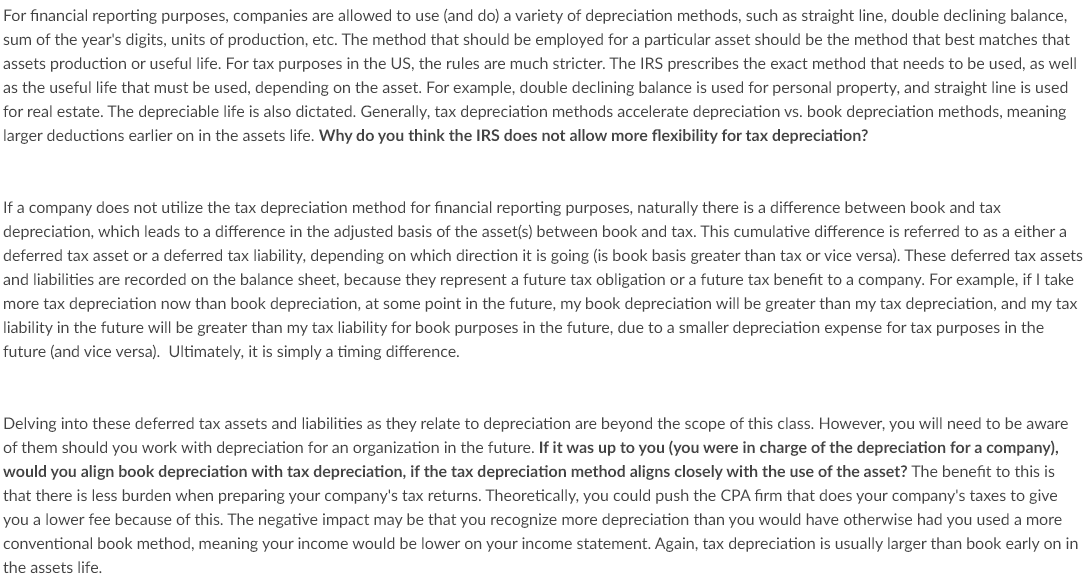
For financial reporting purposes, companies are allowed to use (and do) a variety of depreciation methods, such as straight line, double declining balance, sum of the year's digits, units of production, etc. The method that should be employed for a particular asset should be the method that best matches that assets production or useful life. For tax purposes in the US, the rules are much stricter. The IRS prescribes the exact method that needs to be used, as well as the useful life that must be used, depending on the asset. For example, double declining balance is used for personal property, and straight line is used for real estate. The depreciable life is also dictated. Generally, tax depreciation methods accelerate depreciation vs. book depreciation methods, meaning larger deductions earlier on in the assets life. Why do you think the IRS does not allow more flexibility for tax depreciation? If a company does not utilize the tax depreciation method for financial reporting purposes, naturally there is a difference between book and tax depreciation, which leads to a difference in the adjusted basis of the asset(s) between book and tax. This cumulative difference is referred to as a either a deferred tax asset or a deferred tax liability, depending on which direction it is going (is book basis greater than tax or vice versa). These deferred tax assets and liabilities are recorded on the balance sheet, because they represent a future tax obligation or a future tax benefit to a company. For example, if I take more tax depreciation now than book depreciation, at some point in the future, my book depreciation will be greater than my tax depreciation, and my tax liability in the future will be greater than my tax liability for book purposes in the future, due to a smaller depreciation expense for tax purposes in the future (and vice versa). Ultimately, it is simply a timing difference. Delving into these deferred tax assets and liabilities as they relate to depreciation are beyond the scope of this class. However, you will need to be aware of them should you work with depreciation for an organization in the future. If it was up to you (you were in charge of the depreciation for a company), would you align book depreciation with tax depreciation, if the tax depreciation method aligns closely with the use of the asset? The benefit to this is that there is less burden when preparing your company's tax returns. Theoretically, you could push the CPA firm that does your company's taxes to give you a lower fee because of this. The negative impact may be that you recognize more depreciation than you would have otherwise had you used a more conventional book method, meaning your income would be lower on your income statement. Again, tax depreciation is usually larger than book early on in the assets life. For financial reporting purposes, companies are allowed to use (and do) a variety of depreciation methods, such as straight line, double declining balance, sum of the year's digits, units of production, etc. The method that should be employed for a particular asset should be the method that best matches that assets production or useful life. For tax purposes in the US, the rules are much stricter. The IRS prescribes the exact method that needs to be used, as well as the useful life that must be used, depending on the asset. For example, double declining balance is used for personal property, and straight line is used for real estate. The depreciable life is also dictated. Generally, tax depreciation methods accelerate depreciation vs. book depreciation methods, meaning larger deductions earlier on in the assets life. Why do you think the IRS does not allow more flexibility for tax depreciation? If a company does not utilize the tax depreciation method for financial reporting purposes, naturally there is a difference between book and tax depreciation, which leads to a difference in the adjusted basis of the asset(s) between book and tax. This cumulative difference is referred to as a either a deferred tax asset or a deferred tax liability, depending on which direction it is going (is book basis greater than tax or vice versa). These deferred tax assets and liabilities are recorded on the balance sheet, because they represent a future tax obligation or a future tax benefit to a company. For example, if I take more tax depreciation now than book depreciation, at some point in the future, my book depreciation will be greater than my tax depreciation, and my tax liability in the future will be greater than my tax liability for book purposes in the future, due to a smaller depreciation expense for tax purposes in the future (and vice versa). Ultimately, it is simply a timing difference. Delving into these deferred tax assets and liabilities as they relate to depreciation are beyond the scope of this class. However, you will need to be aware of them should you work with depreciation for an organization in the future. If it was up to you (you were in charge of the depreciation for a company), would you align book depreciation with tax depreciation, if the tax depreciation method aligns closely with the use of the asset? The benefit to this is that there is less burden when preparing your company's tax returns. Theoretically, you could push the CPA firm that does your company's taxes to give you a lower fee because of this. The negative impact may be that you recognize more depreciation than you would have otherwise had you used a more conventional book method, meaning your income would be lower on your income statement. Again, tax depreciation is usually larger than book early on in the assets life







